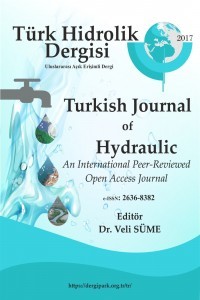Theoretical and Numerical Analysis of Applicability of Elliptical Cross-Section on Energy Dissipation of Hydraulic Jump
Elliptical-shaped contraction, Energy dissipation, Free hydraulic jump, Submerged hydraulic jump
Theoretical and Numerical Analysis of Applicability of Elliptical Cross-Section on Energy Dissipation of Hydraulic Jump
___
- [1] Yarnell, D. L. Bridge piers as channel obstructions. Washington: U.S. Dept. of Agriculture (1934).
- [2] Chow, V. R. Open-Channel Hydraulics. New York: McGraw-Hill (1959).
- [3] Henderson, F. M. Open channel flow. New York: Macmillan (1966).
- [4] Hager, W. H. and Dupraz, P.A. Discharge characteristics of local, discontinuous contractions: Journal of Hydraulic Research, 23(5), 421-433 (1985).
- [5] Wu, B. and Molinas, A. Chocked Flows through Contractions: Journal of Hydraulic Engineering, 127(8), 657-662 (2001).
- [6] Dey, S. and Raikar, R.V. Scour in Long Contractions: Journal of Hydraulic Engineering, 131(12), 1036-1049 (2005).
- [7] Jan, C. D. and Chang, C. J. Hydraulic Jumps in an Inclined Rectangular Chute Contraction: Journal of Hydraulic Engineering, 135(11), 949-958 (2009).
- [8] Das, R. Pal, D. Das, S. and Mazumdar A. Study of Energy Dissipation on Inclined Rectangular Contracted Chute: Arab J Sci Eng 39(10), 6995–7002 (2014).
- [9] Sadeghfam, S. Akhtari, A.A. Daneshfaraz, R. and Tayfur, G. Experimental investigation of screens as energy dissipaters in submerged hydraulic jump: Turkish Journal of Engineering and Environmental Sciences, 38(2), 126-138 (2015).
- [10] Babaali, H. Shamsai, A. and Vosoughifar, H. Computational Modeling of the Hydraulic Jump in the Stilling Basin with Convergence Walls Using CFD Codes: Arab J Sci Eng 40(2), 381–395 (2015).
- [11] Ghaderi A, Dasineh M, Aristodemo F, Ghahramanzadeh A. Characteristics of free and submerged hydraulic jumps over different macroroughnesses. Journal of Hydroinformatics, 22 (6): 1554–1572 (2020).
- [12] Ghaderi A, Dasineh M, Aristodemo F, Aricò C. Numerical Simulations of the Flow Field of a Submerged Hydraulic Jump over Triangular Macroroughnesses. Water, 13(5): 674 (2021).
- [13] Belaud, G. Cassan, L. and Baume, JP. Calculation of Contraction Coefficient under Sluice Gates and Application to Discharge Measurement: Journal of Hydraulic Engineering, 135(12), 1086-109 (2009).
- [14] Nasrabadi, M., Mehri, Y., Ghassemi, A. and Omid, M.H. Predicting Submerged Hydraulic Jump Characteristics Using Machine Learning Methods. Water Supply. 21(8), 4180–4194 (2021).
- [15] Flow Science Inc. 2016 FLOW-3D V 11.2 User’s Manual, Santa Fe, NM, USA; (2016).
- [16] Daneshfaraz, R., Norouzi, R., Abbaszadeh, H., Kuriqi, A., & Di Francesco, S. Influence of Sill on the Hydraulic Regime in Sluice Gates: An Experimental and Numerical Analysis. Fluids, 7(7), 244. https://doi.org/10.3390/fluids7070244 (2022).
- [17] Daneshfaraz, R., Abbaszadeh, H., Gorbanvatan, P., & Abdi, M. Application of Sluice Gate in Different Positions and Its Effect on Hydraulic Parameters in Free-Flow Conditions. Journal of Hydraulic Structures, 7(3), 72-87. (2021).
- [18] Daneshfaeaz, R. Rezazadeh-Joudi, A. and Sadeghfam, S. Experimental Investigation of Energy Dissipation in the Sudden Chocked Flow with free Surfaces: Journal of Civil and Environmental Engineering, 48(2), 101-108 (2018).
- Başlangıç: 2017
- Yayıncı: Veli SÜME
Doğu Karadeniz Havzası’nda Taşkın Sebepleri, Zararları ve Taşkın Yönetimi Çalışmaları
Ömer YÜKSEK, Hasan Törehan BABACAN, Osman YÜKSEK
Kentsel Hidroloji: Türkiye Yağmur Suyu Toplama ve Bertaraf Yönetmeliğine Göre Kentsel Drenaj Durumu
Cevizlik Hidroelektrik Santralinde Soğutma Suyu Sistemi ve İncelenmesi
Osman KURTULUŞ, Mustafa Ergin ŞAHİN, Hasan EROĞLU
Veysel ASLAN, Mehmet Yaşar SEPETÇİOĞLU, Abdurrahman Oktay YAŞAR
